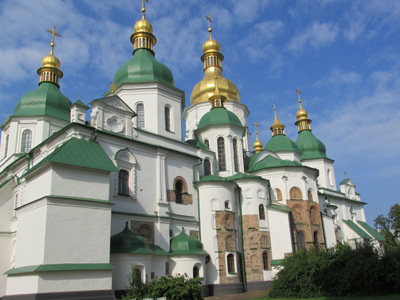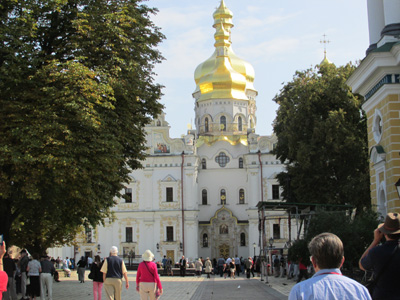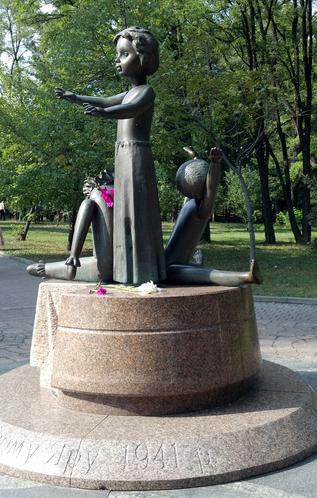Well, Olivia found the answer on
Google, but I asked our tour guide, Alla, what she knew about the mysterious
leaf that seems to appear everywhere. She said it was just
coincidence. However, I mushed on and asked the program director (I
think her name is Alyona) and she says that the horse-chestnut leaf is the
symbol of Kiev. I checked out a page of images and found
this one, which looks like the tree we found around the corner from the
hotel. Mystery solved.
But I digress and there is so
much to talk about today this is going to be a humongous entry.
First of all, we were all
thrilled to wake up to a glorious sunrise and hardly a cloud in the sky.
It gave promise of good weather for our travels.

After breakfast, we started out
on our tour of Kiev, some of which I had seen the day before, most of which
the others had seen the day before. Today we were seeing it by bus,
with stops at strategic places.
The first place we stopped was
back at the Golden Gate and I took a picture I didn't get yesterday, surely
a prime tourist attraction.

Isn't that cute? It's a
coffee cart right next to the famous Golden Gate. I have other good
pix of the GG, but I'll save those for Flickr when I get home 'cause there
is so much other stuff.
After the Golden Gate, we went to
St. Sophia's Cathedral, which is no longer a working church, but is a World
Heritage site. It was built in 1037 (not completed until 1299) by good
ol' Yaroslav the Wise again (that was one busy dude!)

It's a magnificent building (but
you can't take pictures inside), but in truth, I was more interested in the
stuff outside in the courtyard. Some sort of a display of folk
art which may have been in a parade recently (I'm not really a very good
historian!)


But we had to leave the chickens
and go inside and it was a very good tour. As I said, you can't take
pictures, but the place was beautiful, with a sparkling gold and silver
iconostasis (the door that separates the worshippers from the altar).
Not nearly as gaudy as Melk Abbey in Austria that made me so angry last
year!
A cool thing inside the
building was this sarcophagus they found. I've forgotten the date now.
But they dug it up somewhere and when they opened it, they tried to
determine who was inside. Apparently not only was Yaroslav busy
building half the known world, he was also a cripple and by examining the
remains in the sarcophagus, they determined it was ol' Yaroslav himself, so
he now rests inside St. Sophia, which I think is kinda cool.
After we left St. Sophia (through
the "ubiquitous," as Walt and I have come to call gift shops!), we drove to
Cave Monastery, which was founded in...surprise, surprise, the time of
Yaroslav the Wise. This guy was a real over-achiever! It is a small
monastic city, an active monastery with priests and all that stuff, a museum
on the history of the place, and some burial caves. The caves are quite
extensive, but much of the area is not safe, so only a small part is open to
public tours. They are not recommended for *the physically unfit,
*tall people, *people with claustrophobia, and *people with cardiac
problems. I knew instantly that I was not going to go on that part of
the tour, not was Char, but Mike and Walt would go.
Well, when we got there it was
indeed a little city, and the whole place was filled with the sound of that
gorgeous Orthodox chanting.

It reminded me of the days when
we would go to San Francisco once a month, to the Orthodox church that was
run out of a garage, with our friend Andrij. I got to where I could
sing the chants in Russian and it was so nice and familiar to hear it again.
I couldn't get enough of it, but the tour leaders kept droning on about
historical stuff and dates and sizes and battles and I don't know what all,
completely ignoring all the glorious music filling the air. Just totally
ignored the thing I most wanted to hear!
We went into the museum with the
local guide, who was really not very good at all. She had no idea how
large her group was, jammed us all into a teeny room and pointed out things
in cases at the front of the room (I was at the back). When I saw that
the next room was the same, I decided not to take the tour and to just sit
outside and listening to the singing. It was one of the best decisions
I made.
I loved people watching and love
this picture of the priests kibbitzing while the ceremony in the cathedral
was finishing up.

And when all the priests had
filed out of the church and the singing stopped, a guy started ringing a big
bell. A big bell and soon people were standing around and
resting their hands on the bell. It went on for at least half an hour
and then all the bells in the complex started ringing too. When the tour
guide came out of the museum and someone asked her what was going on, she
shrugged and said she didn't know. THAT is a bad tour guide! But
it was one of the most thrilling parts of the day for me, watching those
people touching the bell and the guy who continued ringing it for at least
half an hour. (Another tour guide later told me that people feel that
touching the bell, and feeling the vibration is very restorative and if they
have health problems, they touch the bell when it is being rung.)


(Not all listeners were music
lovers, though)

This was also "register for
school" day and everywhere we went, we saw people buying big bunches of
flowers for their children, and then taking their pictures, all dressed up,
ready for school to start tomorrow.

There was also a wedding party
which processed in, looking like a paparazzi parade, with a whole camera
crew in front of and following the bride and her family.

We returned to the ship and had
about 10 minutes to rest before it was time for lunch. Char opted out
of lunch in favor of resting. At 2 p.m., we got back on the buses and
headed for Babi Yar, the mile and a half long deep ravine in the middle of
the city, where, over two days in September, 1941, the Germans shot and
killed at least 30,771 Jews, men, women and children. The victims were
told they were going to be relocated and asked to bring all of their
belongings. And they showed up, afraid that if they did not, they would be
shot. They were asked to remove their jewelry, deposit their valuables,
and ultimately strip naked, stand at the edge of the ravine and be shot,
their bodies falling into the ravine. Very efficient. The massacre was
the largest single mass killing of the Nazi regime and is considered to be
the "largest single massacre in the history of the Holocaust."
I don't know how the tour leader
can lead these tours. I don't know how long she has been doing it, but
she still gets emotional as she shows the well worn pictures and tells the story and
admits that nobody really knows the total body count because the Germans,
realizing they were not going to win, tried to cover up by digging up the
bodies and burning them in the concentration camp ovens. I think she
said that to date only 10% of the victims of this slaughter have been
positively identified.
Today it is a peaceful place.
You walk up this long path to a giant menorah

(the menorah is at the far end of this long path)

You pay your respects and then
kind of meander down through this lovely grassy glen until you realize that
this was the spot. Here and extending a mile and a half from here.

In your mind you hear the screams
of the terrified women and children as they are pushed, naked, to the edge
and the guns open fire. The tour guide, stifling emotion, passes around
well worn pictures of the soldiers, the bodies, the clothing. And when you turn
to walk back to the bus, there is nothing to say. You are drained and
shocked and so very, very sad.

The bus makes two mores stops at
other memorials in this very beautiful park, where parents pick up leaves
with their toddlers and dog walkers walk their dogs and lovers walk hand in
hand and whisper sweet nothings to each other. The one that gets you
is the memorial to the children who were killed in the holocaust in Ukraine.
I believe she said over 10,000 ... but by now the numbers are too large to
comprehend.

We ended our tour at the oldest
synagogue in Kiev, the one that survived during the German occupation
because, like St. Sophia, the Germans took control of the building to stable
their horses in.

The rabbi had a small underground
congregation and opened a matzo bakery where local people could pick up
their matzo for Passover. The rabbi of today, a right jolly old elf,
told us, through an interpreter, about the history of this place, where the
money came from to rebuild, and build a school as well. It's a
beautiful building.

Our very busy day ended with
vodka and tonic on the sun deck, watching the sun go down as the ship pulled
away from the dock and headed down the Dneiper, under a canopy of gathering
storm clouds.


Just as we were saying goodbye to
Kiev, the skies opened up and it started to pour. We were very lucky
weatherwise today.

It was a very full day, but I am going to sleep tonight thinking of 33,771 men, women and children toppling into a ravine. It's hard to wrap your head around. Well, you can wrap your head around it, but you can never get the visuals out of your mind. And that is the point of memorial parks like Babi Yar. Never forget.
DINNER OF THE DAY

Starter: prawn in some sort of
coconut sauce
Oxtail soup (never had it before; won't again)
Chateaubriand...yummy
Pot de creme, with minted pineapple chunks
Oxtail soup (never had it before; won't again)
Chateaubriand...yummy
Pot de creme, with minted pineapple chunks

No comments:
Post a Comment